

Following last week's Organic Apple Growing presentations by Paul Ward and Matthew Wilson, this week The English Apple Man looks at the Pest & Disease (P&D) challenges facing Organic Top Fruit Growers in greater detail.
With the help of Simon van der Slikke, owner of Capman Systems and advisor to The English Apple Man in his days as an Apple Grower nearly 25 years ago, we looked at what are the most difficult challenges when growing Organic Top Fruit in the UK.
Tree health!
Like human beings, a 'healthy' specimen (person or tree) will stand up to the challenge of disease more readily than an 'unhealthy' specimen. Many factors contribute to the health of the tree. How can we make the tree build up its natural defence mechanism?
Simon said soil quality is an essential element, determined by a complex mechanism, but essentially composed of 45% soil minerals, 25% water and 25% air with organic matter active aerobic soil microbes.
Decomposing organic matter releases nutrients and water into the soil and is a source of energy for the soil microbes. The fully decomposed material is called humus and this can hold 10 times its weight in water, up to 300,000 litres of water per hectare for each 1% increase in humus in the top 15 cm of top soil. Cationic nutrients attach themselves to humus, reducing the loss of potash, calcium and other cations through leaching. Humus stimulates biological processes in the soil. Animal manures, green waste (compost) and industrial waste (shoddy and paper waste) are notable sources of organic matter.
Mycorrhizae
In the picture, the yellow colour is the root system of the tree, while the white is the mycorrhizae attached to the host (tree roots) and capable of delivering efficient uptake of nutrients to the tree system.
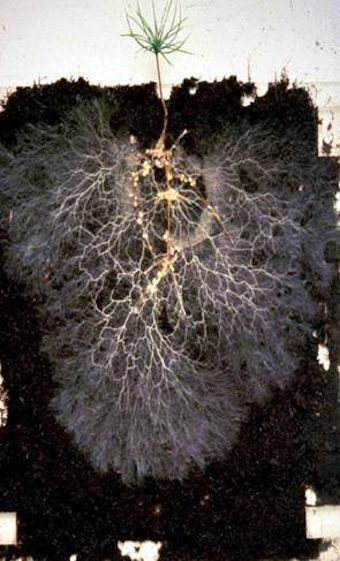 Mycorrhizae is becoming increasingly harnessed for new plantings; in this case apple trees.
Mycorrhizae is becoming increasingly harnessed for new plantings; in this case apple trees.
To assist establishment, growers treat the tree roots with root promoting mychorrizae before planting. The fungi colonize the roots and improve nutrient uptake, especially phosphorus which aids establishment of the new tree. Interestingly mycorrhizae cannot exist without the tree (plant) as a host, however the tree (plant) does not need the mycorrhizae but in the right circumstances, benefits from the interaction with mycorrhizae.
Mycorrhizae can be described as a symbiotic relationship between a fungus and a plant. Due to the fact that this is a symbiotic relationship, both the fungus and the plant benefit from this interaction. Since the plants are above ground, it is often easier to see the benefits of this association for the plant, but the fungus also takes advantage of this partnership.
The mycorrhizae aid the plant with growth, yield, improved fitness, increase the root absorption area of nutrients, while the fungus receives carbon and energy from the associated plant. This is an important interaction due to the benefits that the plants receive. Improved plant growth and yield can aid in the production of crops and therefore produce more plants per area.
Although mycorrhizae produce the same overall effects, there are two main types of this fungus. Endomycorrhizae and ectomycorrhizae are the two main types of mycorrhizae that produce the same overall results, but with different fungal characteristics.
Elicitors (A substance or other stimulus that triggers the hypersensitive response in a plant)
Simon explained how 'plant defence elicitors' are less effective in controlling pests and diseases when plants are under stress, but they can keep plants healthy when soil conditions are good and when plant nutrition is in balance. The elicitors interact with the plasma membrane of undamaged cells and trigger activation of genes involved in the defence response.
Looking back to last week's Organic presentations by Paul Ward and Matthew Wilson, we discussed the different methods adopted by the two Organic growers. While Paul has favoured a more 'high tech' approach with his trees on M9 (dwarfing) rootstock and mechanical cultivation of the strip beneath the trees, Matthew has adopted MM111 (a stronger) rootstock and planted them less intensively, with grass allowed to grow 'right up to' the tree trunk.
Matthew told the meeting he had carried out a trial (as part of the Organic LINK project) where an orchard of Fiesta had generous applications of Nitrogen - as compost; e.g. 'high nutrition' programme over a 5 year period. Matthew said he had another identical Fiesta orchard in the next field, which he gave no applications of nutrients.
At the end of the 5 year trial; both orchards had identical yields and quality. He believes - left to its own devices, the spectrum of beneficial wild flowers in the sward and the natural build up of mycorrhizae had delivered all the nutrients the tree needed.
Simon reiterated those sentiments, demonstrating the 'high tech' v 'low tech' approaches; take two identical orchards; plant one and feed nutrients via fertigation and soil applied fertilizers; plant the second orchard and apply no irrigation or fertilizers.
Orchard 1. will crop earlier and for the first seven years will outperform Orchard 2. BUT after seven years, the cropping performance will change as the yield and fruit size in Orchard 1. drops off while Orchard 2. catches up and yield and size exceeds the performance of Orchard 1.
Pest & Disease Control
First on the list; Apple Scab.
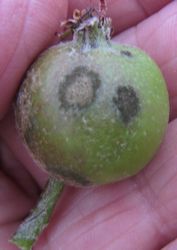 Controlling Scab, whether Organically or Conventionally grown, starts with one golden rule: protect the new green leaf from the first emergence of green tissue at the 'bud break stage' by applying an approved fungicide.
Controlling Scab, whether Organically or Conventionally grown, starts with one golden rule: protect the new green leaf from the first emergence of green tissue at the 'bud break stage' by applying an approved fungicide.
Conventionally - the 'first application would be with Copper Oxycloride - 'pre bud burst' followed by, for example; Dodine, Dithianaon, Captan' ....
Organically - Option 1). Lower rate of Copper Oxycloride (125 grammes of active ingredient) per hectare every 5 days from Bud burst to end of June. Option 2). Pottasium Bicarbonete as 1% concentration + a wetter 'or it will not work' with liquid seaweed the organic option as a wetter.
A wetter improves the efficacy of the fungicide.
A Copper spray is only a 'short term' protectant; e.g. it has no 'eradicant properties' but 1 kg of Hydrated Lime per hectare IS an eradicant BUT MUST be sprayed within 9 hours of a scab infection to work!
The challenge for Organic apple growers is the limited weapons (sprays) available and the importance of 'timing' is critical. Conventional apple growing has a few more weapons; namely synthetic fungicides with longer protectant efficacy and the benefit of more efficient eradicant properties.
Second on the list; Mildew.
 Mildew 'overwinters' on buds/shoots infected the previous season, and 'becomes active' when the new growth starts in springtime; stopping the sporulation from overwintering shoots and secondary lesions on young foliage is the summer challenge. Allowing the build up of too much mildew will stunt the tree vigour and can cause 'disfiguring russet on the fruit as well.
Mildew 'overwinters' on buds/shoots infected the previous season, and 'becomes active' when the new growth starts in springtime; stopping the sporulation from overwintering shoots and secondary lesions on young foliage is the summer challenge. Allowing the build up of too much mildew will stunt the tree vigour and can cause 'disfiguring russet on the fruit as well.
While Sulphur has been the 'standard' for Organic mildew control, Simon points out it has the unfortunate ability to wipe out the predatory mite Phytosieulus pyri which feeds on Red spider mites and are now integral to IPM (Integrated Pest Management) used in conventional produced apple orchards where Sulphur is substituted with synthetic pesticides. However a mixture of Pottasium Carbonate and Pottasium silicate can be used for Mildew and leave the predatory Phytosieulus pyri unharmed. This combination has the dual capability of combating Scab & Mildew.
Apple Blossom Weevil
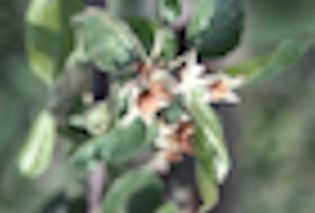 Described by Paul Ward, Matthew Wilson and Simon as the most important (challenging) pest for Organic Apple growers. The weevil builds up year on year, with the classic capping of blossoms turning brown instead of opening at blossom time. Uncontrolled ABW suddenly becomes a very serious issue. Combating ABW with Pyrethrum is an approved control, but timing is critical as the control is only effective for 24 hours and it costs £70 per hectare.
Described by Paul Ward, Matthew Wilson and Simon as the most important (challenging) pest for Organic Apple growers. The weevil builds up year on year, with the classic capping of blossoms turning brown instead of opening at blossom time. Uncontrolled ABW suddenly becomes a very serious issue. Combating ABW with Pyrethrum is an approved control, but timing is critical as the control is only effective for 24 hours and it costs £70 per hectare.
Pyrethrum is a botanical insecticide which is extracted from a species of daisy flower (Tanacetum cinerariaefolium). Pyrethrum is the active ingredient in products for use in both conventional and organic pest control.
Below left: An Adult Apple Blossom Weevil - Below right: this ABW Larvae hard at work destroying the flower bud.
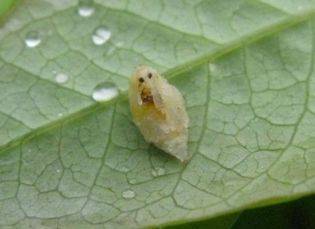
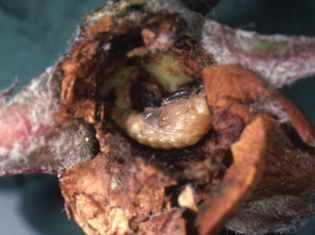
 Green Apple Aphids
Green Apple Aphids
The main concern when assessing Green Apple Aphid infestation is when the trees are young and infestation of the young 'growing tips' will spoil the growth of the tree. It is not so much a problem on established trees.
Winter Moth Caterpillar
 Winter moth caterpillars eat holes in the leaves, blossom and developing fruitlets of many tree fruits, ornamental trees and shrubs. Severe attacks can weaken plants. Extensive damage to fruit trees can affect crop yields and quality. Early damage on apple fruitlets causes a deep cleft in the side of the fruits to develop by the time they have reached full size in late summer
Winter moth caterpillars eat holes in the leaves, blossom and developing fruitlets of many tree fruits, ornamental trees and shrubs. Severe attacks can weaken plants. Extensive damage to fruit trees can affect crop yields and quality. Early damage on apple fruitlets causes a deep cleft in the side of the fruits to develop by the time they have reached full size in late summer
Spinosad is available for Organic control of Winter Moth caterpillar, but the Soil Association want to know what it is being used for as they are concerned that it should not be 'over used'
Spinosad is a natural insecticide. The active ingredients in spinosad, spinosyn A and spinosyn D, are complex organic compounds made by specific a actinomycete ( a soil microbe).
Spinosad is a broad-spectrum, organic insecticide. The term "broad-spectrum" means that it is toxic to a wide variety of insects. It is, however, relatively non-toxic to mammals and beneficial insects. If used carefully only insects that actually eat something that has been treated, such as a leaf, are affected. This is different than a lot of other broad-spectrum insecticides that are toxic if the insect merely comes in contact with dry insecticide residues.
Bacillus thuringiensis, which is commonly known as Bt, is an effective, natural and safe microbial pesticide specifically targeting caterpillar pests. Bt sprayed during blossom combats Winter Moth Caterpillars.
 Red Spider
Red Spider
Red spider used to be a serious problem requiring pesticide applications to keep it under control. Left uncontrolled the red spider mites would suck the life out of the leaves resulting in bronzed leaves. The introduction of Phytosieulus pyri changed the game completely; aligned with an understanding of which pesticides killed Phytosieulus pyri, a more empathatic spray selection has resulted in a rare need to spray for Red Spider in Conventional apple orchards.
In Organic orchards, Red spider can be suppressed with regular sprays with seaweed extract and the placement of predators such as typhlodromus pyri or Amblyseius californucus.
Canker
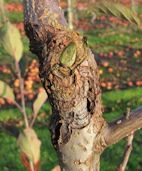 Simon pointed out that Canker is more prevalent in soils with low available Calcium and some varieties need more calcium than others. Spartan for instance appears to require more than some other varieties and is one of the varieties very prone to Canker. Low levels of Copper Oxycloride contain Canker but Simon said Copper is on the list for withdrawal from use.
Simon pointed out that Canker is more prevalent in soils with low available Calcium and some varieties need more calcium than others. Spartan for instance appears to require more than some other varieties and is one of the varieties very prone to Canker. Low levels of Copper Oxycloride contain Canker but Simon said Copper is on the list for withdrawal from use.
Wooly Aphids
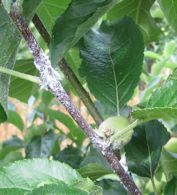 When Organic apple growers face an infestation of Wooly aphids - control relies on a parasitic wasp, Aphelinus mali, which usually lays it's eggs in the aphids from July onwards.
When Organic apple growers face an infestation of Wooly aphids - control relies on a parasitic wasp, Aphelinus mali, which usually lays it's eggs in the aphids from July onwards.
Although woolly aphid populations rarely get large enough to harm most plants, the distorted and curled leaves they cause and leave behind can certainly become unsightly.
Much like other types of aphids, these sap-sucking insect pests are small (1/4 inch). However, woolly aphids, which are green or blue, also appear fuzzy due to the white, waxy material that covers their body. These pests generally use two hosts: one for overwintering and laying eggs in spring, and one for feeding in summer.
Woolly aphid insects generally feed in groups. They can be seen feeding on foliage, buds, twigs and branches, bark, and even the roots. Damage may be recognized by twisted and curled leaves, yellowing foliage, poor plant growth, branch die-back, or the development of cankers and gall on limbs or roots.
Since severe woolly aphid attacks rarely occur, there is little need for woolly aphid pesticide for control. Generally, their numbers are kept low with natural predators like lacewings, ladybugs, hover flies, and parasitic wasps.
Codling 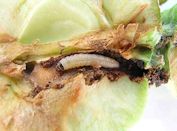
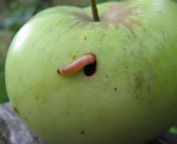 Codling Moth can be controlled with Carpovisusene, which contains a virus disease that is specific to Codling moth. Or Soil applied Nematodes and Pheromone Disruptors are increasingly being used for Codling Moth control.
Codling Moth can be controlled with Carpovisusene, which contains a virus disease that is specific to Codling moth. Or Soil applied Nematodes and Pheromone Disruptors are increasingly being used for Codling Moth control.
Summer Fruit Tortrix 
Summer Fruit Tortrix just like Codling Moth can do considerable damage.
The summer fruit tortrix moth is an important secondary pest of apples and pears, especially in eastern and south-eastern England. The life cycle involves two generations a year in the UK.
Short stalked varieties such as Bramley and Discovery are most susceptible, but all varieties of apple and pear may be attacked.
Damage to foliage is unimportant but damage to fruits occurs at three different times during fruit development.
Spinosad - used as a pre-blossom application is the choice for control of Summer Fruit Tortrix in Organic Apple Orchards.
Summarising the challenges of growing Apples Organically in England, The English Apple Man reiterates the views of Simon van der Slikke; "growing apples organically can be less expensive in terms of material inputs, e.g. the spray programme may well be less than the cost of Conventional apple production, however the 'timing of controls (applications) IS CRITICAL and only those growers prepared to pay that attention to detail will be able to succeed.
Conventional apple production has adopted lessons learnt from Organic and in particular IPM (integrated pest management) principles 'honed' by scientists, agronomists and forward thinking growers.
Apple growing is a challenging business; either Conventional or Organic and requires dedicated growers of either system to stand a chance of success. The profits are unpredictable, luck definitely comes into the equation. Weather, Politics - UK and Global et al play a part in success or failure. Being good at growing does not ensure success, albeit improving the 'game of chance' but with this season proving unprofitable for most apple growers and many feeling their investment in recent years a financial 'burden' not being reimbursed by prices they are receiving, we can only hope for a better balance between 'supply and demand' in the season ahead!
The English Apple Man recommends my readers take a look at Simon van der Slikke's Capman Systems website.
That's all for this week.......
Take care
The English Apple Man